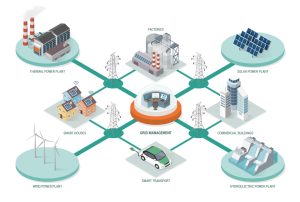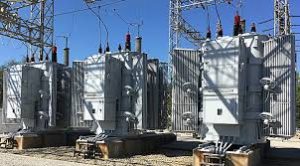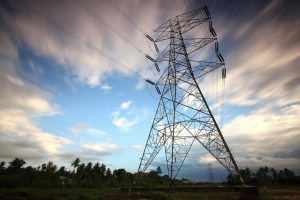
In today’s fast-paced world, efficient and sustainable use of energy has become a critical concern. Load management plays a vital role in optimizing energy consumption and ensuring the reliable operation of electrical grids.
Load management refers to the strategic management of electricity demand to match it with the available supply. By effectively managing peak demand and load fluctuations, businesses and utilities can avoid costly blackouts, reduce energy wastage, and lower operational expenses.
Did you know that according to the U.S. Energy Information Administration, commercial and industrial sectors account for nearly two-thirds of the total electricity consumption in the United States? It’s clear that implementing effective load management techniques can have a significant impact on energy conservation and cost savings.
However, load management also presents its own set of challenges, such as maintaining a delicate balance between supply and demand, adapting to changing load profiles, and integrating renewable energy sources into the grid. Let’s explore various techniques and strategies for load management, along with their benefits and considerations. So, this is the time to dive in and uncover the secrets to efficient load management!
Peak Demand and Load Profile
Peak demand is the maximum amount of electricity consumed within a specific time period. It typically occurs during periods of high energy consumption, such as hot summer days or during business hours when commercial activities are at their peak. Understanding peak demand is crucial because it helps utilities and businesses plan and allocate resources effectively to meet the highest energy demand levels.
While I was searching for writing my assignment on the internet, I found that according to experts, load profile refers to the detailed record of electricity consumption over a given period. It provides valuable insights into how and when electricity is used, allowing for better load management strategies. By analyzing load profiles, energy providers can identify patterns, peak demand periods, and areas for improvement in energy efficiency. Load profiles are essential for optimizing energy supply, implementing demand response programs, and identifying opportunities for load shifting and load balancing.
Load profiles vary across different industries. For instance, the manufacturing sector often has consistent energy consumption during working hours, while the hospitality industry experiences peak demand during evenings and weekends when guests are active. Residential load profiles typically show a surge in energy usage in the mornings and evenings as households wake up and return home from work. Understanding load profiles specific to different industries helps tailor load management techniques to their unique needs, maximizing efficiency and minimizing costs.
Remember, peak demand and load profile analysis lay the foundation for effective load management strategies. By leveraging this knowledge, businesses and utilities can make informed decisions to optimize energy consumption and enhance sustainability.
Load Shifting
- Load shifting involves the intentional adjustment of electricity consumption patterns to shift peak demand to periods of lower energy demand. This technique helps alleviate strain on the electrical grid during peak hours while promoting energy efficiency and cost savings. By redistributing energy usage throughout the day, load shifting can contribute to a more stable and sustainable energy system.
There are several techniques for load shifting:
1. Time-based load shifting
This technique involves shifting electricity consumption to off-peak hours when energy demand is lower. For example, businesses may schedule non-essential tasks or equipment operation during nights or weekends when electricity rates are typically lower. This helps reduce peak demand and lower energy costs.
2. Temperature-based load shifting
This technique focuses on adjusting heating, ventilation, and air conditioning (HVAC) systems to optimize energy usage. By slightly adjusting temperature setpoints or implementing pre-cooling or pre-heating strategies, energy consumption can be shifted to times when energy demand is lower without compromising comfort levels.
3. Process-based load shifting
This technique involves optimizing energy-intensive processes to minimize electricity consumption during peak demand periods. For instance, industrial facilities can adjust production schedules to avoid high energy usage during peak hours or implement energy-efficient technologies that reduce power requirements.
Load shifting offers several benefits and considerations:
Benefits
- Reduced electricity costs: Shifting energy consumption to off-peak hours can take advantage of lower electricity rates, resulting in cost savings for businesses and consumers.
- Grid stability: By reducing peak demand, load shifting helps maintain grid stability and reduces the risk of blackouts or brownouts.
- Energy efficiency: Load shifting encourages the efficient use of electricity, leading to reduced overall energy consumption and environmental impact.
Considerations
- Operational impact: Load shifting may require adjustments to business operations, equipment scheduling, or production processes. It is essential to assess and plan for any potential impacts on workflow or productivity.
- Behavioral change: Load shifting often involves changes in energy consumption patterns, which may require education and awareness campaigns to encourage consumer or employee participation.
- System limitations: Load shifting effectiveness may be limited by factors such as infrastructure capacity, grid constraints, or the availability of alternative energy sources.
By implementing load shifting techniques, businesses and individuals can contribute to a more sustainable energy future while enjoying the benefits of cost savings and grid reliability. However, it is essential to consider the specific needs and constraints of each situation to ensure successful load shifting strategies.
Peak Load Reduction
Peak load reduction refers to the intentional reduction of electricity consumption during periods of high demand, particularly during peak hours. It plays a crucial role in maintaining grid stability and avoiding power outages. By implementing effective peak load reduction strategies, businesses and utilities can alleviate stress on the electrical grid and ensure a reliable and sustainable energy supply.
There are three basic techniques for peak load reduction:
1. Demand response programs
These programs involve incentivizing consumers to reduce their electricity usage during peak demand periods. Participants can voluntarily adjust their energy consumption or allow the utility to remotely control certain appliances or equipment. By actively managing demand, utilities can effectively reduce peak loads and balance electricity supply and demand.
2. Energy storage systems
Energy storage technologies, such as batteries, play a significant role in peak load reduction. During periods of low demand, excess energy is stored in batteries. When demand surges, stored energy is discharged to meet the increased load, reducing reliance on the grid and mitigating peak demand.
3. Distributed generation
Distributed generation refers to the production of electricity at or near the point of consumption. It involves utilizing small-scale power generation sources, such as solar panels or small wind turbines. By generating electricity locally, distributed generation reduces the strain on the grid during peak hours and contributes to peak load reduction.
Various Case Studies
Successful peak load reduction projects have been implemented across various industries and regions:
- Case study 1:
A utility company in Virginia implemented a demand response program that encouraged residential customers to reduce their energy consumption during peak periods. Through incentives and education campaigns, the program achieved a significant reduction in peak demand, resulting in improved grid reliability and reduced operational costs.
- Case study 2:
A manufacturing facility in Manchester installed an energy storage system to store excess energy during off-peak hours. During peak demand periods, the stored energy was discharged, reducing the facility’s reliance on the grid and minimizing peak load. This not only improved grid stability but also resulted in cost savings for the facility.
- Case study 3:
In a rural community, a combination of distributed generation sources, such as solar panels and small wind turbines, was deployed. This decentralized approach to power generation reduced the community’s dependence on the grid, especially during peak load periods, ensuring a reliable and resilient energy supply.
These case studies highlight the effectiveness of peak load reduction techniques in diverse settings. By implementing demand response programs, leveraging energy storage systems, and embracing distributed generation, businesses and communities can contribute to a more sustainable and stable energy landscape while reaping the benefits of cost savings and improved reliability.
Demand Side Management
Demand side management (DSM) refers to the strategic planning and implementation of measures to influence and manage electricity consumption on the consumer side. DSM aims to optimize energy usage, reduce peak demand, and enhance overall energy efficiency. By focusing on consumer behavior and energy consumption patterns, DSM offers a holistic approach to energy management.
There are several techniques and strategies for demand side management:
1. Energy efficiency measures
Improving energy efficiency through practices such as energy-efficient lighting, insulation, and appliance upgrades can significantly reduce overall energy consumption. By promoting energy-efficient technologies and educating consumers about energy-saving habits, DSM encourages sustainable energy use.
2. Load control and curtailment
Load control involves the ability to remotely control and adjust electricity usage during peak demand periods. This can be achieved through time-of-use pricing, where consumers pay different rates based on the time of day. Curtailment refers to voluntary reduction of electricity usage during critical periods, incentivized through demand response programs.
3. Smart grid technologies
Smart grid technologies enable two-way communication between utilities and consumers, facilitating real-time data exchange and enabling demand response capabilities. Smart meters, for instance, provide detailed consumption information, allowing consumers to monitor and manage their energy usage more effectively.
Demand side management offers several benefits and faces certain challenges:
Benefits
- Lower energy costs: DSM can result in reduced electricity bills through energy efficiency measures and demand response programs that incentivize off-peak usage.
- Enhanced grid reliability: By reducing peak demand, DSM contributes to grid stability, reducing the risk of blackouts and improving system resilience.
- Environmental sustainability: DSM promotes energy conservation, which helps reduce greenhouse gas emissions and supports sustainable energy goals.
Challenges
- Behavioral change: Encouraging consumers to adopt energy-saving practices and participate in demand response programs requires awareness, education, and incentives to change behaviors.
- Infrastructure requirements: Implementing smart grid technologies and deploying advanced metering infrastructure may require significant investments and upgrades to existing systems.
- Balancing consumer comfort and energy savings: DSM initiatives must strike a balance between energy efficiency and maintaining consumer comfort and satisfaction.
Despite the challenges, demand side management presents immense opportunities for energy conservation and cost savings. By implementing energy efficiency measures, enabling load control, and leveraging smart grid technologies, businesses and consumers can actively participate in shaping a more sustainable energy future while enjoying the benefits of reduced energy costs and a more reliable grid.
Load Balancing
Load balancing involves the equitable distribution of electricity demand across the electrical grid to ensure optimal utilization of resources and maintain grid stability. The primary objectives of load balancing are to avoid overloading specific parts of the grid, minimize the risk of blackouts, and optimize the use of available energy supply.
There are several techniques for load balancing:
1. Load shedding
Load shedding is the controlled and temporary reduction of electricity supply to specific areas or consumers during periods of high demand. By shedding non-critical loads or prioritizing essential services, load shedding helps balance the supply-demand equation and prevent grid instability.
2. Load aggregation
Load aggregation involves grouping multiple smaller loads together to create a larger, more manageable load. This technique allows for more efficient distribution and utilization of available energy resources. For example, aggregating the electricity demand of several households or small businesses can create a load profile that is easier to balance and manage.
3. Load leveling
Load leveling aims to smooth out fluctuations in electricity demand by shifting some of the peak load to off-peak periods. This technique involves actively managing energy consumption to minimize sharp spikes in demand and ensure a more consistent and manageable load profile.
Load balancing techniques are implemented across various sectors:
- Residential sector
Smart home technologies enable load balancing by optimizing energy usage based on consumer preferences and real-time data. For example, smart thermostats can adjust temperature settings during peak demand hours to reduce electricity consumption without sacrificing comfort.
- Commercial sector
Large office buildings and commercial complexes implement load balancing strategies to manage energy demand from various systems, such as lighting, HVAC, and equipment. Load shedding and load leveling techniques are often employed to avoid excessive strain on the grid during peak periods.
- Industrial sector
Industries with high energy requirements, such as manufacturing plants and data centers, utilize load balancing techniques to optimize energy usage and maintain grid stability. Load aggregation may be employed to manage multiple smaller loads within the facility effectively.
Effective load balancing ensures a more reliable and efficient electricity supply. By implementing load shedding, load aggregation, and load leveling techniques, utilities and consumers can contribute to a more stable grid, reduce energy wastage, and enhance overall system performance across residential, commercial, and industrial sectors.
Energy Management Systems (EMS)
Energy management systems (EMS) are comprehensive tools that enable businesses and utilities to monitor, control, and optimize their energy usage. EMS provides a centralized platform for managing energy data, analyzing consumption patterns, and implementing energy-saving strategies.
EMS typically consists of various features and components, including real-time monitoring of energy consumption, data collection and analysis, automated control systems, and reporting capabilities. It may also integrate with other smart technologies, such as smart meters and building automation systems, to enhance energy management capabilities.
EMS plays a crucial role in load management by providing valuable insights into energy usage patterns, identifying opportunities for load optimization, and enabling proactive energy management strategies. It allows for real-time monitoring and control of energy consumption, facilitating load shifting, load balancing, and peak load reduction techniques. With its comprehensive features and functionalities, EMS empowers businesses and utilities to make informed decisions and implement effective load management practices, ultimately leading to energy efficiency and cost savings.
While Summing Up…
Understanding different techniques of load management is essential for optimizing energy consumption, ensuring grid stability, and promoting sustainability. Through peak demand and load profile analysis, businesses and utilities can identify patterns and develop strategies to effectively manage energy usage. Techniques such as load shifting, peak load reduction, demand side management, load balancing, and the implementation of energy management systems all contribute to efficient load management.
These techniques offer numerous benefits, including reduced energy costs, enhanced grid reliability, improved energy efficiency, and environmental sustainability. However, challenges such as behavioral change, infrastructure requirements, and balancing consumer comfort and energy savings need to be considered when implementing load management strategies.
By embracing these techniques and strategies, businesses, utilities, and individuals can actively participate in creating a more sustainable energy future. Efficient load management not only leads to cost savings and a more reliable energy supply but also contributes to the overall well-being of the environment by reducing carbon emissions and minimizing the strain on the electrical grid. Together, let’s unlock the potential of load management and pave the way for a more sustainable energy landscape.





